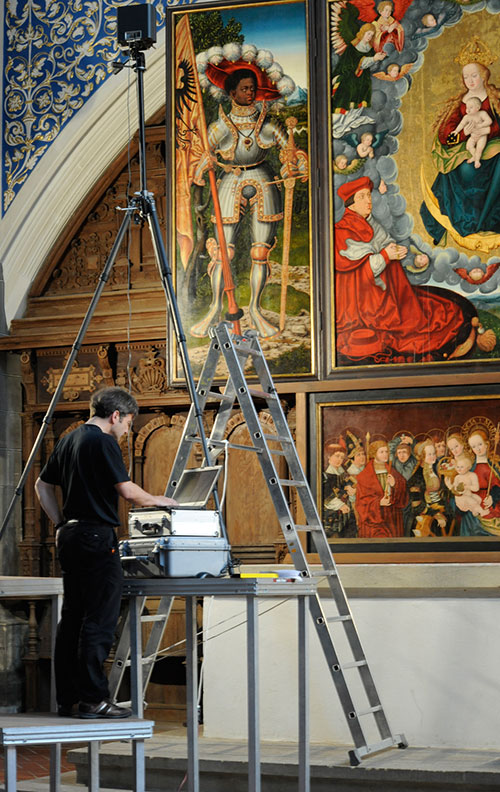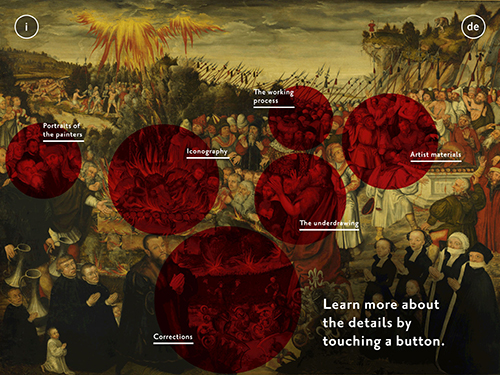
The prints and drawings

Left: Lucas Cranach the Elder, St George, about 1505, pen and brush, grey ink with highlights in white on paper with grey wash (detail), Szépmuvészeti Múzeum Budapest; Right: Lucas Cranach the Elder, Venus and Cupid, 1509, coloured print on paper (detail), Staatliche Museen zu Berlin - Preußischer Kulturbesitz, Kupferstichkabinett
In March 2023, the Cranach Digital Archive began a new project phase to research the prints and drawings by Lucas Cranach the Elder, his sons and his workshop.
The aim of the project is to examine the c. 300 drawings and the c. 600 prints, including their different states and impressions. For the first time this oeuvre will be systematically catalogued employing an interdisciplinary approach that combines the fields of art history, artistic techniques, conservation science and computer science. The results will be freely accessible to both scholars and the general public.
The project aims to gain a broader understanding of the works, their creation, and their significance through the application of methods from the humanities and scientific research that have already been successfully used by the cda to examine paintings. In dialogue with art-historical research the systematic technical examination of a representative selection of drawings and prints, focusing on the support and the drawing and printing techniques, promises to yield new insights into the working methods within the Cranach workshop. It will provide new evidence concerning attribution and dating, the original contexts and function of the artworks, as well as publication processes and artistic exchange.
Art Technological Examination of Paintings

Examination of the Altarpiece of the Virgin (1529) in the Marktkirche at Halle
In cooperation with our partners the cda-team has examined 1139 paintings in 152 collections and churches employing new methods such as infrared reflectography, that enables the compositional design beneath the paint layers to be seen. By this means new insights were gained concerning the working process and the division of labour within the Cranach workshop. The results of the examination are freely accessible in the research archive and publications evaluating the results can be downloaded (see below).
Transcriptions from Archival Material
Numerous archival documents relating to Lucas Cranach the Elder in the Ernestine Archive were digitalized for the first time for the Cranach Digital Archive in cooperation with the Central State Archive of Thuringia, Weimar and transcribed anew by Monika and Dieter Lücke. At present receipts from account books (40 files with c. 100 pages of archival material) listing invoices for material and contract work, including the work for the castle of Torgau, various letters and the ‘Turkish tax’ tax register for the town of Wittenberg have been published online.
Documents from the city archive in Kronach recording the court case against the Cranach family have for the first time been completely processed and published.
At present about 1,000 receipts from the city archive of Wittenberg (up to 1550) are being processed, as well as the archive of St. Maria, the parish church of Wittenberg. To complement this, further documents in the Thuringia Central Archive in Weimar will be accessed, as well as documents in the State archives of Dresden, Schwerin and Magdeburg.
The network of trade and travel routes used by Cranach the Elder
Screenshot of animation
For the exhibition 'Cranach. Meister - Marke - Moderne' (Museum Kunstpalast, Düsseldorf 8 April - 30 July 2017) the Cranach Digital Archive created an animated presentation, illustrating the extensive network of trade and travel routes used by Lucas Cranach the Elder.
The Sacrifice of Elijah

Screenshot of presentation
In 2015 the Cranach Digital Archive was one of the cooperation partners for the exhibition "Lucas Cranach der Jüngere. Entdeckung eines Meisters“ in Wittenberg and for this context prepared a presentation, which includes the research results concerning the painting "The Sacrifice of Elijah", owned by the Stadtgeschichtliche Museum Leipzig (to painting).
It was lent to the exhibition (26 June - 1 Nov 2015) and is now on display in the Stadtgeschichtliche Museum Leipzig.
Publications

Lucas Cranach the Elder, Holy Family (Rest on the Flight into Egypt), 1504. Detail Staatliche Museen zu Berlin, Preußischer Kulturbesitz, Gemäldegalerie. Detail: Maria and child, infrared reflectogram
Since the beginning of the project (2009) the cda-team has also contributed to numerous printed scholarly publications:
Görres, D., Klinke, T., Martin Luther als „Junker Jörg“. Zur Entstehung und den Auflagen eines Holzschnitts Lucas Cranachs des Älteren, In: W. Greiling, U. Schirmer, E.A. Werner (eds.) Luther auf der Wartburg 1521/1522. Bibelübersetzung – Bibeldruck – Wirkungsgeschichte (Quellen und Forschungen zu Thüringen im Zeitalter der Reformation 13), Cologne 2023, 297–320.
Heydenreich, G., Görres, D, Wismer, B. (eds.) Lucas Cranach der Ältere: Meister – Marke – Moderne, exhibition catalogue Museum Kunstpalast, Düsseldorf. Munich (2017).
Heydenreich, G., Die Veränderungen des Zwickauer Cranach-Retabels im Entstehungsprozess – Ergebnisse strahlendiagnostischer Untersuchungen. In: T. Pöpper (ed.) Cranach in Zwickau. Das Retabel in der St. Katharinenkirche, Regensburg (2017) 111–120.
Heydenreich, G., Görres, D., Herrschaft, J., Die Werkstatt Cranachs des Jüngeren. In: R. Enke, K. Schneider, J. Strehle (eds.) Lucas Cranach der Jüngere. Entdeckung eines Meisters, Munich (2015) 64-77.
Werner E.A., Eusterschulte A., Heydenreich G. (eds.) Lucas Cranach der Jüngere und die Reformation der Bilder. Munich (2015).
Lücke, M., Lucas Cranach d. J. als Unternehmer. In: E.A. Werner, A. Eusterschulte, G. Heydenreich (eds.) Lucas Cranach der Jüngere und die Reformation der Bilder. Munich (2015) 30-41.
Lücke, D., Die Cranach-Familie in den Grumbach'schen Händeln. In: E.A. Werner, A. Eusterschulte, G. Heydenreich (eds.) Lucas Cranach der Jüngere und die Reformation der Bilder. Munich (2015) 52‒61.
Görres, D., Cranach, Luther und die Ernestiner. Der Epitaphaltar der Stadtkirche St. Peter
und Paul in Weimar. In: F. Bomski, H. Th. Seemann, Th. Valk (eds.) Bild und Bekenntnis. Die Cranach-Werkstatt in Weimar (Jahrbuch der Klassik Stiftung Weimar), Göttingen (2015) 37-53.
Heydenreich, G., Sandner, I., Smith-Contini, H., Der Streit um die Autorschaft. Das Weimarer Cranach-Retabel im Lichte technologischer Untersuchungen. In: F. Bomski, H. Th. Seemann, Th. Valk (eds.) Bild und Bekenntnis. Die Cranach-Werkstatt in Weimar (Jahrbuch der Klassik Stiftung Weimar), Göttingen (2015) 193-204.
Herrschaft, J., Heydenreich, G., A Lucretia by Lucas Cranach the Elder at the Bilbao Fine Arts Museum. In: Bulletin of the Bilbao Fine Arts Museum 8 (2014) 15-39.
Heydenreich, G., The Cranach Digital Archive: challenges and perspectives for interdisciplinary research in digital transformation. In: Smolnik, R. (ed.) CIDOC 2014. Annual Conference. Access and Understanding – Networking in the Digital Era, 6th – 11th September 2014, Dresden (2014) 47.
Heydenreich, G., Das Cranach Digital Archive – eine Ressource für interdisziplinäre Forschung. In: A. Bienert, F. Weckend, J. Hemsley (eds.) Konferenzband: EVA2013 Berlin. Elektronische Medien & Kunst, Kultur, Historie. 6.-8. November 2013, Berlin (2013) 43-48.
Heydenreich, G., The Cranach Digital Archive: Challenges and Perspectives for Collaborative Art Technological and Art Historical Research, In: Postprints of the 33rd Congress of the International Committee of the History of Art (CHIA2012), 15th – 20th July 2012, Nuremberg (2013).
Heydenreich, G., Beobachtungen zum Werkprozess. In: Pöpper, T. (ed.) Das Schneeberger Reformationsretabel von Lucas Cranach dem Älteren. Altenburg (2013) 108-117.
Heydenreich, G., Reisende Bilder im Wandel. In: G. Messling (ed.) Die Welt des Lucas Cranach. Ein Künstler im Zeitalter von Dürer, Tizian und Metsys , exhibition catalogue, Brussels (2010) 66‒79.
(a more detailed list of publications by the authors is available in the bibliographical database)